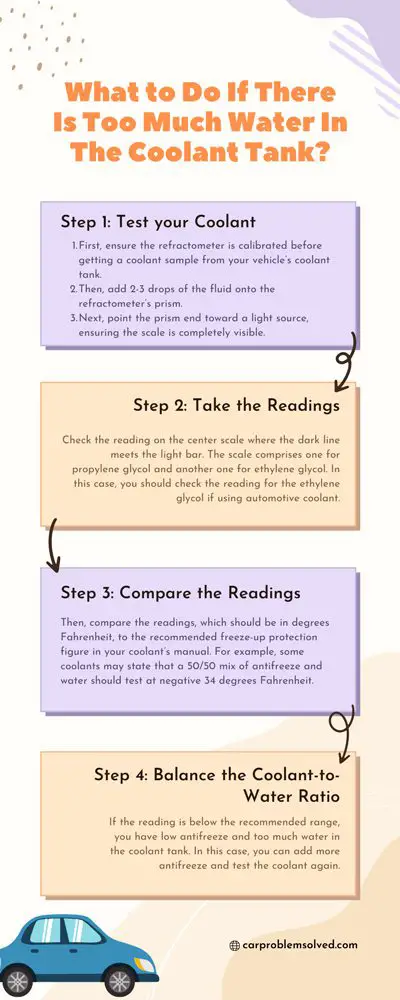Your car’s coolant helps keep the engine from overheating, which could cause damage to various engine components. However, when there is too much water in the coolant tank, this may reduce the coolant’s freeze protection. As a result, the engine may overheat.
So then, how do you remove water from your car’s coolant tank? Well, there are two straightforward and inexpensive ways. The first uses a siphoning device, and the other uses a shop vacuum.
But wait, that’s not all! Read this guide, we will discuss everything there is to know about removing water from your vehicle’s coolant tank.
Importance of the Proper Balance of Coolant and Water in Preventing Engine Overheating
The correct coolant and water balance may vary based on what is the coldest temperature in the area you live in. But generally, most coolants typically comprise a mix of 50:50 antifreeze and water.
And where the temperatures are freezing, the coolant may contain up to 70% antifreeze and 30% water. The coolant may contain 70% water and 30% antifreeze in moderate climates.

That said, maintaining the correct balance is critical in preventing engine overheating problems and ensuring its long life. Consequently, this may help avoid the following:
- Cracked engine block
- Warped, bent, and deformed engine cylinders and pistons
- Failed and leaking head gasket
- Loss of engine pressure and poor performance
- Knocking and grinding noises as engine components scrape against each other
- Safety risks like loss of control and possible crash
- Expensive engine repairs
What to Do If There Is Too Much Water In The Coolant Tank?
If you add too much water to the coolant tank, you must determine the percentage of antifreeze in the coolant. This way, you will know whether you need to remove the water or add more coolant.

In this case, you can use a hand refractometer. This tool measures the glycol concentration, giving you the antifreeze freezing point. Below is how to determine the percentage of antifreeze:
Step 1: Test your Coolant
- First, ensure the refractometer is calibrated before getting a coolant sample from your vehicle’s coolant tank.
- Then, add 2-3 drops of the fluid onto the refractometer’s prism.
- Next, point the prism end toward a light source, ensuring the scale is completely visible.
Step 2: Take the Readings
Check the reading on the center scale where the dark line meets the light bar. The scale comprises one for propylene glycol and another one for ethylene glycol. In this case, you should check the reading for the ethylene glycol if using automotive coolant.

Step 3: Compare the Readings
Then, compare the readings, which should be in degrees Fahrenheit, to the recommended freeze-up protection figure in your coolant’s manual. For example, some coolants may state that a 50/50 mix of antifreeze and water should test at negative 34 degrees Fahrenheit.
Step 4: Balance the Coolant-to-Water Ratio
If the reading is below the recommended range, you have low antifreeze and too much water in the coolant tank. In this case, you can add more antifreeze and test the coolant again.
Alternatively, drain the old coolant and refill it with the correct antifreeze-to-water ratio mixture. This is the easiest method.
Steps for Removing Water from the Coolant Tank

You can use two methods to remove water from the coolant tank. Let’s find out how each one works.
1. Using a Siphon
A siphon is simply a bent tube that allows liquids to flow upward and then down to a lower level via gravity. Here is how to use the tube to remove water from the coolant tank in about 15 minutes:
Step 1: Find the Coolant Reservoir Tank
- Park your vehicle on a level surface and let the engine cool down.
- Then, locate the coolant tank, which is typically a translucent plastic container near the engine.
Step 2: Remove the Water
- Wear some gloves and remove the cap from the coolant tank.
- Then, insert one end of the siphoning device into the coolant tank.
- After that, place a bucket below the car and put the other end of the tube in it.
- Next, start squeezing the ball on the siphoning device while holding the end of the tube inside the bucket with your finger. This will help build pressure.
- Then, release your finger once the fluid starts flowing out of the coolant tank.
- Using a Vacuum Tool

A shop vacuum is yet another effective tool for removing water from coolant tank. Here is how it works.
Step 1: Disconnect the top and bottom of the radiator hose.
Step 2: Place a bucket underneath the disconnected hose at the bottom.
Step 3: Connect your vacuum hose to the opening of your vehicle’s coolant tank.
Step 4: Turn the vacuum device on. You should see the coolant from the coolant tank draining into the bucket via the bottom hose.
How To Properly Refill the Coolant Tank with the Appropriate Coolant?

You can use a vacuum tool, also known as a coolant refill kit. Below are steps on how to use the tool.
Step 1: Take off the cap on the coolant tank.
Step 2: Insert the gauge assembly of your vacuum refill tool into the tank’s neck and tighten it. If it does not fit properly, you can use a rubber adapter.
Step 3: Open the valve on the tool and then close it once the needle on the gauge touches the green markers. This is to eliminate as much air as possible from the cooling system.
Step 4: If your coolant is not already premixed, mix equal parts of coolant and of water in a bucket.
Step 5: Insert the tool’s intake hose (the screened end) in the bucket with the coolant. Ensure the hose goes all the way to the bottom.
Step 6: Open the valve. You should see the coolant traveling through the hose to the coolant tank. The coolant is filled to the correct level when the gauge readings drop to zero (red marker).
Step 7: Uninstall the vacuum refill tool and reinstall the cap on the coolant tank.
Tips for Preventive Maintenance to Avoid Coolant-Relate Problems

Below we will discuss the various maintenance tips that can help you avoid coolant-related issues.
Regular Maintenance
This involves checking the coolant level regularly and replacing it every so often, as recommended by the manufacturer.
Coolant System Checks
This preventive maintenance tip is about checking for leaks in the coolant system. Also, you should check the hoses for cracks, the water pump, and the radiator fins for any damage.
Monitoring Temperature Gauge
A temperature gauge is designed to measure the temperature of the engine coolant. So, monitoring the indicator can help you know when the temperatures get too hot, allowing you to take action early on.
Correct Coolant
You must ensure to use the proper coolant type for your car. More so, you must correctly dilute the coolant with water in the correct ratio.
When it comes to maintaining your car’s cooling system, understanding how to remove water from the coolant tank is crucial. However, if you’re facing coolant leakage issues after replacing the water pump, it’s essential to address the problem promptly. Our article on coolant leaking after replacing water pump provides insights into potential causes and solutions for this specific issue. Additionally, if you find that your car is going through coolant rapidly, it’s important to identify the underlying reasons. Our article on why is my car going through coolant so fast discusses various factors that could contribute to excessive coolant consumption. By exploring these related topics, you can effectively troubleshoot coolant-related concerns and ensure the optimal performance of your vehicle’s cooling system.Conclusion
Ensuring the right balance of coolant and water in your vehicle’s coolant tank has many benefits. First, it ensures your car’s engine remains at the ideal operating temperature, preventing overheating. It also helps minimize the risk of corrosion on the cooling system components.
The correct coolant-to-water balance may also enhance your vehicle’s engine performance and longevity. Even better, it can improve your car’s fuel consumption. This is because when the coolant-to-water ratio is off balance, the engine has to work hard to maintain optimal temperature.
